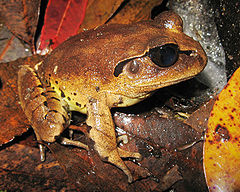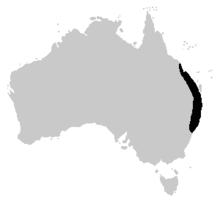- Great Barred Frog
-
Great Barred Frog 
Conservation status Scientific classification Kingdom: Animalia Phylum: Chordata Class: Amphibia Order: Anura Family: Myobatrachidae Subfamily: Limnodynastinae Genus: Mixophyes Species: M. fasciolatus Binomial name Mixophyes fasciolatus
Gunther, 1864
Range of the Great Barred Frog The Great Barred Frog (Mixophyes fasciolatus) is an Australian ground-dwelling frog of the genus Mixophyes.
Contents
Physical description
The Great Barred Frog reaches a size of 8 centimeters, and has large, powerful legs. It has a dark brown dorsal surface, and a white ventral surface. The thighs are yellow blotched with black, and it has parallel black bars along the legs. A dark line begins at the snout, passes through the eye, over the tympanum, and bends down behind the tympanum. Its feet are fully webbed, and hands completely un-webbed. Its eyes are on top of the head, and the tympanum is visible.
Ecology and behaviour
The Great Barred Frog is a ground-dwelling frog, which inhabits rainforests, Antarctic beech forests or wet sclerophyll forests. This frog breeds in both streams and ponds and calls from the surrounding land. All the other frogs of the genus Mixophyes breed only in streams. The mating call is a very loud "wark-wark-wark" which is occasionally followed by a softer "bwak-bwak".
The male and female Great Barred Frog will enter the water for amplexus. After laying the eggs, the female will flick them onto the bank for development. The eggs will then be washed into the stream or pond after the first rain, and hatch into tadpoles.
The Great Barred Frog is almost always found near running water. Its powerful legs, and webbed feet allow it to escape predation by hopping large distances into water, and quickly swimming away.
As a pet
It is kept as a pet[1], in Australia this animal may be kept in captivity with the appropriate permit.
References
- ^ Mark Davidson. 2005. Australian Reptile Keeper Publications. ISBN 0-975820-00-1
- Hines et al. (2004). Mixophyes fasciolatus. 2006. IUCN Red List of Threatened Species. IUCN 2006. www.iucnredlist.org. Retrieved on 11 May 2006. Database entry includes a range map and justification for why this species is of least concern
Categories:- IUCN Red List least concern species
- Mixophyes
- Amphibians of Queensland
- Amphibians of New South Wales
- Pet amphibians
Wikimedia Foundation. 2010.


